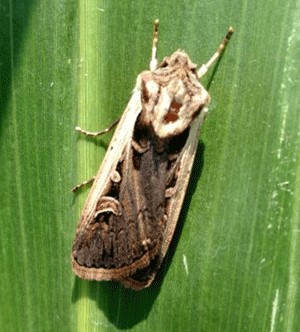By Jeanne Falk Jones and Sarah Zukoff
As the corn in northwest Kansas continues to move through the final vegetative stages of growth and tassels have just started to emerge, Western Bean Cutworm (WBC) is a pest to monitor. Reports of western bean cutworm egg masses in northwest and west central Kansas began over the last week and scouting has begun.
Life cycle of Western Bean Cutworm
The life cycle for the western bean cutworm includes the adults emerging from the soil in late June and early July, then they mate and begin to lay eggs. Western bean cutworm moths (Figure 1) lay eggs in clusters of 5 to 200 on the top surface of the upper 1/3 of a corn plant, near the whorl (Figure 2). The eggs require five to seven days to develop. During this time, the egg color changes from a cream-tan color to purple just prior to hatching. After hatching, the larva first feed on the tassels and pollen and then they migrate to the silks and ear of the plant (Figure 3). In addition, open wounds on the ear from feeding can result in secondary infections. After about a month of development and several instars, they drop to the soil surface, burrow 3 to 6 inches in the soil and create an overwintering cell. They will remain in this cell until emergence the following June.

Figure 1. Adult western bean cutworm found on upper 1/3 of corn plant in Cheyenne Co. Front wings are brown with distinctive pattern (shown). The bottom wings are solid cream colored (not shown). Photo by Jeanne Falk Jones, K-State Research and Extension.
Figure 2. Western bean cutworm egg mass, found on upper corn leaf surface near the stalk. Photo by Jeanne Falk Jones, K-State Research and Extension.
Figure 3. Hatching western bean cutworm egg mass. The larvae will feed on pollen and migrate to the tassel. Photo by Jeanne Falk Jones, K-State Research and Extension.
Scouting tips
When scouting for western bean cutworms in corn, check 20 plants in at least five areas of each field. Look for eggs on the top surface of the upper most leaves or look for larvae in the tassel. Western bean cutworm moths prefer to lay eggs in corn plants that are in the late whorl stage compared to those that have completely tasseled, so keep this in mind when scouting.
If you have Bt corn, you might think that you do not need to monitor the western bean cutworm pressure. However, there is just one type of Bt protein that provides reliable protection against western bean cutworm: VIP3A. Products that express the VIP3A protein, such as Agrisure Viptera, Leptra, and Trecepta, provide effective control and should not need to be treated, although it is always advised to scout.
The Cry1F protein, present in products such as Herculex 1, Herculex XTRA, AcreMax, and SmartStax is not labeled for western bean cutworm. Although, it has provided protection against WBC in previous years, with approximately 80% control of western bean cutworm when it was first released in 2003. However, this protein has lost efficacy in the last 10 years due to the development of resistance. It is recommended that fields with Cry1F products be scouted for western bean cutworm and insecticide treatment considered, if above the economic threshold.
Treatment decisions – Know the threshold
When making insecticide treatment decisions, it is important to know the threshold of the western bean cutworm. For corn hybrids that do not provide Bt control of western bean cutworm, consider applying an insecticide if 5-8% of the corn plants have egg masses or larvae. This is the threshold for both dryland and irrigated corn, although keep yield potential in mind.
If an insecticide treatment is warranted in corn, it should be made when 95% of the plants in a field have tasseled. This application timing increases the chance that the worms will be feeding on the new pollen and they exposed to the insecticide, resulting in better control. If larvae have already moved into the ears, they will be protected from insecticide by the husks and cannot be effectively controlled. Insecticide application via chemigation has provided very good control of this insect, as long as the nozzles are above the ear height.
There are many treatments labeled for control of western bean cutworm. They include Carbamates (Sevin), organophosphates (Chlorpyrifos), spinosyns (Spinosad), methoxyfenozides (Intrepid), diamides (Prevathon), indoxacarb (Steward) and many pyrethroids (>50 commercial products) are labeled for control of western bean cutworm. Be sure to follow insecticide labels for application details. Consider rotating insecticide active ingredients to help prevent resistance, especially in areas where pyrethroids have been used for control in prior years or for control of western corn rootworm. Some insecticides, such as Prevathon and Steward, have been shown to have a lower impact on beneficial insects (such as lady beetles and lacewings). Preserving these predators in the field can provide some natural control of WBC eggs and larvae.
Source : ksu.edu